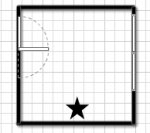Hi everyone!
I am currently working on improving the acoustics in my home recording studio. I know there are many knowledgeable people here, and I am hoping to learn something from what you have to share.
To start, here is a floor plan of my studio room:

It is a 11' x 11' x 8' bedroom with shag carpet.
The star shows the location of my desk / studio monitors.
There are 2 big windows that are shown on the right side of the room. They are covered by miniblinds.
I was am planning on starting out by adding bass traps to get rid of some of the low end buildup in the corners. There are some 12" x 12" x 24" bass traps that are being sold in a 6 pack on ebay for about $140. They look very similar to the Auralex panels I have seen.
I was going to go ahead and get these, but I read somewhere that foam panels may not do much to absorb frequencies lower than 150 hz. Can anyone confirm if this is true or not?
If it is true, what should I do?
The room I am using has a ton of metallic sounding echo when I clap, and I believe it is due to the fact that there is a drum kit in the back right corner. I hear that drum kits will cause problems for the acoustics if the room isn't treated. Do you think the bass traps will help remove this metallic echo?
Also, I am worried that these 6 bass traps may deaden this room too much.
I am really in the dark on this one. I have tried to research as much as possible but it seems like everyone says something different about what should be done. Can anyone here give me some advice on what would be the best way to acoustically treat this room?
I am currently working on improving the acoustics in my home recording studio. I know there are many knowledgeable people here, and I am hoping to learn something from what you have to share.
To start, here is a floor plan of my studio room:

It is a 11' x 11' x 8' bedroom with shag carpet.
The star shows the location of my desk / studio monitors.
There are 2 big windows that are shown on the right side of the room. They are covered by miniblinds.
I was am planning on starting out by adding bass traps to get rid of some of the low end buildup in the corners. There are some 12" x 12" x 24" bass traps that are being sold in a 6 pack on ebay for about $140. They look very similar to the Auralex panels I have seen.
I was going to go ahead and get these, but I read somewhere that foam panels may not do much to absorb frequencies lower than 150 hz. Can anyone confirm if this is true or not?
If it is true, what should I do?
The room I am using has a ton of metallic sounding echo when I clap, and I believe it is due to the fact that there is a drum kit in the back right corner. I hear that drum kits will cause problems for the acoustics if the room isn't treated. Do you think the bass traps will help remove this metallic echo?
Also, I am worried that these 6 bass traps may deaden this room too much.
I am really in the dark on this one. I have tried to research as much as possible but it seems like everyone says something different about what should be done. Can anyone here give me some advice on what would be the best way to acoustically treat this room?
